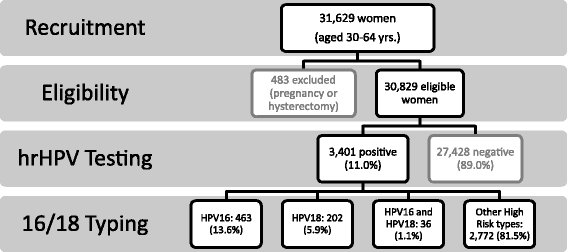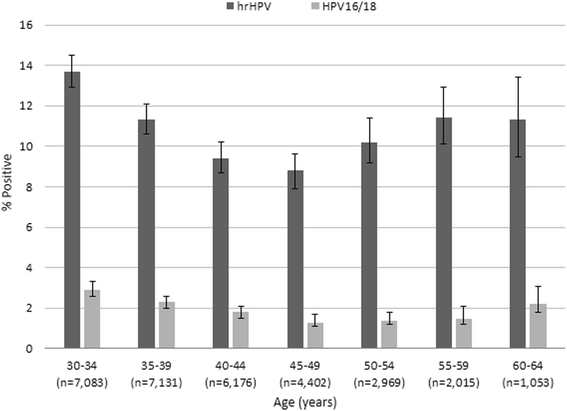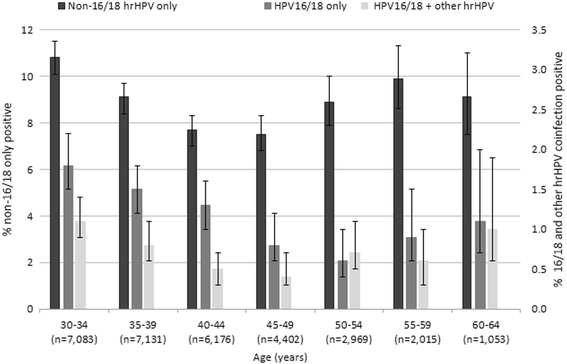Population-based prevalence of cervical infection with human papillomavirus genotypes 16 and 18 and other high risk types in Tlaxcala, Mexico
- PMID: 27585544
- PMCID: PMC5008001
- DOI: 10.1186/s12879-016-1782-x
Population-based prevalence of cervical infection with human papillomavirus genotypes 16 and 18 and other high risk types in Tlaxcala, Mexico
Abstract
Background: Cervical cancer remains an important cause of cancer mortality for Mexican women. HPV 16/18 typing may help to improve cervical cancer screening. Here we present the prevalence of high-risk human papillomavirus (hrHPV) including HPV16 and HPV18 from the FRIDA (Forwarding Research for Improved Detection and Access) population.
Methods: Beginning in 2013, we recruited 30,829 women aged 30-64 in Tlaxcala, Mexico. Cervical samples were collected and tested for 14 hrHPV genotypes (16, 18, 31, 33, 35, 39, 45, 51, 52, 56, 58, 59, 66, and 68). We used logistic regression to estimate odds ratios with 95 % confidence intervals for hrHPV infections according to putative risk factors.
Results: Prevalence of infection with any of the 14 hrHPV types was 11.0 %. The age-specific prevalence of all hrHPV formed a U-shaped curve with a higher prevalence for women aged 30-39 and 50-64 than women aged 40-49. Across all age groups, 2.0 % of women were positive for HPV16 and/or HPV18 (HPV16/18), respectively. HPV16/18 prevalence also showed a U-shaped curve with increased prevalence estimates for women aged both 30-39 and 60-64. Both prevalence curves had a significant quadratic age coefficient. Infections with hrHPV were positively associated with an increased number of lifetime sexual partners, a history of sexually transmitted disease, being unmarried, use of hormonal contraception, having a history of smoking and reported condom use in the multivariate model.
Conclusions: The FRIDA population has a bimodal distribution of both hrHPV and HPV16/18 positivity with higher prevalences at ages 30-39 and 60-64. These findings will help to evaluate triage algorithms based on HPV genotyping.
Trial registration: The trial is registered with ClinicalTrials.gov, number NCT02510027 .
Keywords: HPV16/18; Human papillomavirus DNA testing; Mexico; Prevalence; Risk factors.
Figures



Similar articles
-
Triage strategies in cervical cancer detection in Mexico: methods of the FRIDA Study.Salud Publica Mex. 2016 Apr;58(2):197-210. doi: 10.21149/spm.v58i2.7789. Salud Publica Mex. 2016. PMID: 27557378
-
Co-infections of HPV16/18 with other high-risk HPV types and the risk of cervical carcinogenesis: A large population-based study.Gynecol Oncol. 2019 Dec;155(3):436-443. doi: 10.1016/j.ygyno.2019.10.003. Epub 2019 Oct 8. Gynecol Oncol. 2019. PMID: 31604662
-
Methylation estimates the risk of precancer in HPV-infected women with discrepant results between cytology and HPV16/18 genotyping.Clin Epigenetics. 2019 Oct 12;11(1):140. doi: 10.1186/s13148-019-0743-9. Clin Epigenetics. 2019. PMID: 31606044 Free PMC article.
-
Prevalence and distribution of human papillomavirus genotypes in cervical intraepithelial neoplasia in China: a meta-analysis.Arch Gynecol Obstet. 2020 Dec;302(6):1329-1337. doi: 10.1007/s00404-020-05787-w. Epub 2020 Sep 10. Arch Gynecol Obstet. 2020. PMID: 32914222 Free PMC article. Review.
-
Correlation of human papillomavirus 16 and 18 with cervical cancer and their diagnosis methods in Iranian women: A systematic review and meta-analysis.Curr Probl Cancer. 2020 Feb;44(1):100493. doi: 10.1016/j.currproblcancer.2019.06.008. Epub 2019 Jul 2. Curr Probl Cancer. 2020. PMID: 31285056
Cited by
-
Prevalence and Risk Factors for High-Risk Human Papillomavirus Infection and Cervical Disorders: Baseline Findings From an Human Papillomavirus Cohort Study.Cancer Control. 2023 Jan-Dec;30:10732748231202925. doi: 10.1177/10732748231202925. Cancer Control. 2023. PMID: 37751562 Free PMC article.
-
Sexual behavior and infection with cervical human papillomavirus types 16 and 18.Int J Womens Health. 2019 Aug 26;11:489-494. doi: 10.2147/IJWH.S218441. eCollection 2019. Int J Womens Health. 2019. PMID: 31692583 Free PMC article.
-
The clinical effectiveness of one-dose vaccination with an HPV vaccine: A meta-analysis of 902,368 vaccinated women.PLoS One. 2024 Jan 5;19(1):e0290808. doi: 10.1371/journal.pone.0290808. eCollection 2024. PLoS One. 2024. PMID: 38180991 Free PMC article.
-
Prevalence, persistence, clearance and risk factors for HPV infection in rural Uyghur women in China.BMC Womens Health. 2023 Aug 15;23(1):433. doi: 10.1186/s12905-023-02558-y. BMC Womens Health. 2023. PMID: 37582764 Free PMC article.
-
The Clinical Effectiveness of Single-Dose Human Papillomavirus Vaccination.Vaccines (Basel). 2024 Aug 23;12(9):956. doi: 10.3390/vaccines12090956. Vaccines (Basel). 2024. PMID: 39339988 Free PMC article. Review.
References
-
- Bruni L, Barrionuevo-Rosas L, Albero G, Aldea M, Serrano B, Valencia S, Brotons M, Mena M, Cosano R, Muñoz J, Bosch FX, de Sanjosé S, Castellsagué X. ICO Information Centre on HPV and Cancer (HPV Information Centre). Human Papillomavirus and Related Diseases in Mexico. Summary Report 2016-02-26. http://www.hpvcentre.net/statistics/reports/MEX.pdf. [Accesed 22 Aug 2016].
-
- Walboomers JMM, Jacobs MV, Manos MM, Bosch FX, Kummer JA, Shah KV, Snijders PJF, Peto J, Meijer CJLM, Muñoz N. Human Papillomavirus is a necessary cause of invasive cervical cancer worldwide. J Pathol. 1999;189:12–19. doi: 10.1002/(SICI)1096-9896(199909)189:1<12::AID-PATH431>3.0.CO;2-F. - DOI - PubMed
-
- Muñoz N, Mendez F, Posso H, Molano M, van de Brule AJC, Ronderos M, Meijer CJLM, Muñoz A. Incidence, duration, and determinants of cervical human papillomavirus infection in a cohort of Colombian women with normal cytological results. J Infect Dis. 2004;190:2077–2087. doi: 10.1086/425907. - DOI - PubMed
-
- de Sanjose S, Quint WG, Alemany L, Geraets DT, Klaustermeier JE, Lloveras B, Tous S, Felix A, Bravo LE, Shin H-R, Vallejos CS, de Ruiz PA, Lima MA, Guimera N, Clavero O, Alejo M, Llombart-Bosch A, Cheng-Yang C, Tatti SA, Kasamatsu E, Iljazovic E, Odida M, Prado R, Seoud M, Grce M, Usubutun A, Jain A, Suarez GA, Lombardi LE, Banjo A, et al. Human papillomavirus genotype attribution in invasive cervical cancer: a retrospective cross-sectional worldwide study. Lancet Oncol. 2010;11:1048–1056. doi: 10.1016/S1470-2045(10)70230-8. - DOI - PubMed
MeSH terms
Associated data
Grants and funding
LinkOut - more resources
Full Text Sources
Other Literature Sources
Medical

